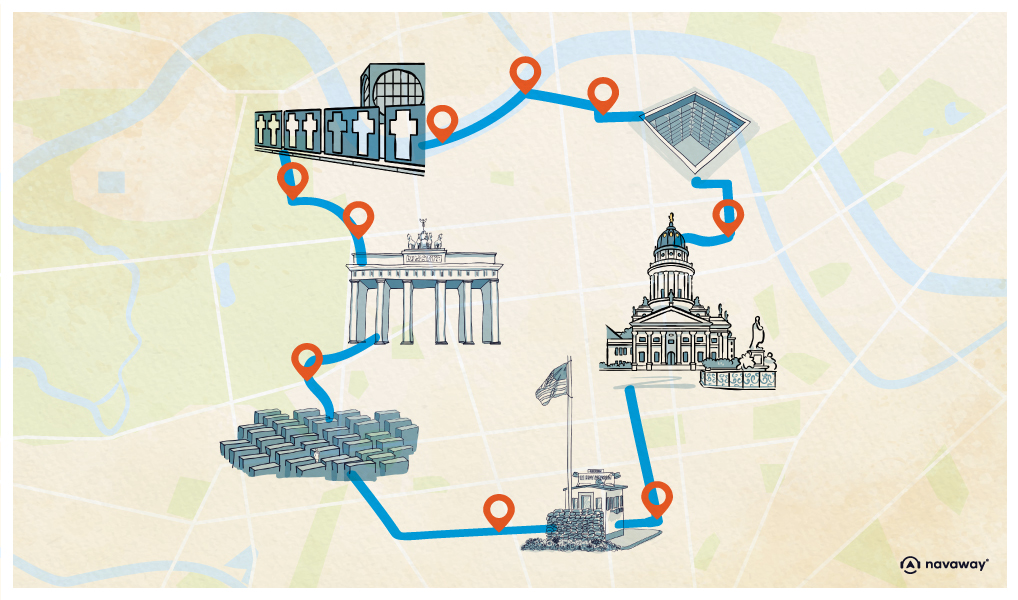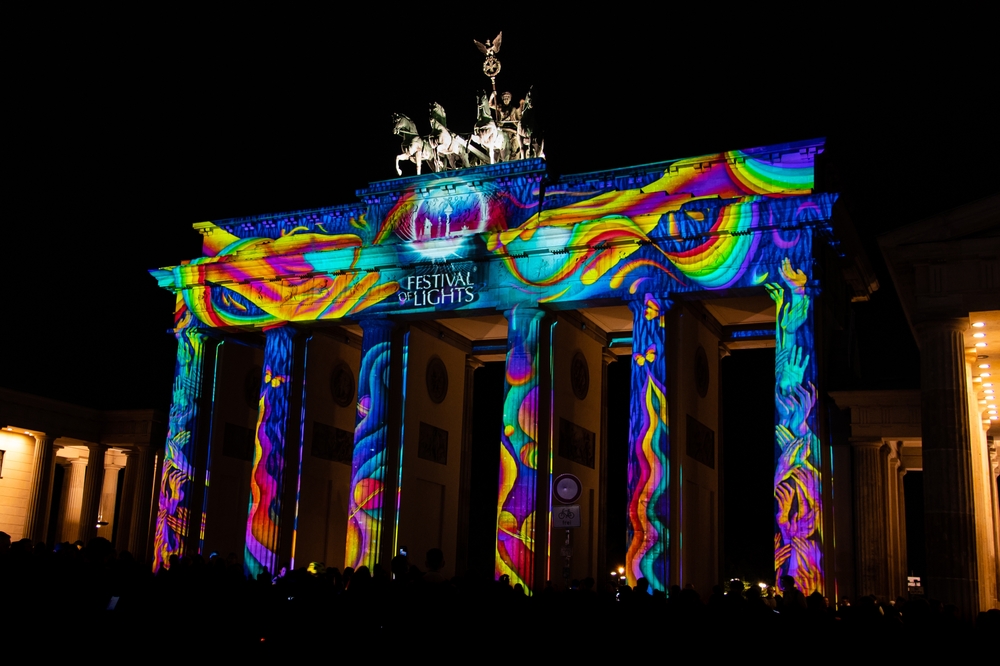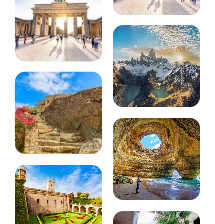
Festival of Lights: Berlin lights up magically

Every autumn, Berlin is transformed into a gigantic open-air gallery of light art. The Festival of Lights, a not-to-be-missed free event in the German capital, transforms the city’s iconic monuments into spectacular canvases thanks to breathtaking light projections and world-renowned 3D mapping.

What is the Berlin Festival of Lights?
The Festival of Lights Berlin is a free international arts event that has been taking place every year since 2005. For eight consecutive nights in October, over 50 of Berlin’s iconic landmarks are lit up with creative light projections, art installations and 3D mapping shows.
Created by Birgit Zander, this festival transforms the German capital into a giant stage where monuments, historic buildings and public squares become the stars of a magical light show. Every year, the event attracts millions of visitors from all over the world, confirming Berlin as a major cultural destination in Europe.
Download the audio tour to discover Berlin on foot and on your own
If you’re coming to Berlin for the Festival of Lights, it’s the perfect opportunity to discover the city from a whole new angle. Our Berlin sightseeing itinerary allows you to explore on foot the main monuments that are illuminated during the festival, while discovering their fascinating history thanks to our entertaining audio guides.

Also read the Berlin guide:
- Top 10 culinary specialities in Berlin
- Top 7 things to do in Berlin
- Historic monuments in Berlin
- Top 5 hotels to stay in Berlin
Festival of Lights 2025 dates and times
The 21st Festival of Lights will take place from 8 to 15 October 2025, under the theme “Let’s shine together”. As every year, the illuminations will be visible from 7pm to 11pm every evening, allowing visitors to enjoy the show to the full after sunset.
This 2025 edition promises to be exceptional, with never-before-seen installations celebrating unity, community and human connections through the art of light. As the festival has been entirely free since its inception, it remains true to its philosophy of offering an artistic gift accessible to all, Berliners and international visitors alike.
Emblematic monuments illuminated
The Festival of Lights transforms Berlin’s most iconic sites into spectacular works of light art. Here are the must-sees on your visit to Berlin:
The Brandenburg Gate

A landmark symbolising Berlin and German reunification, the Brandenburg Gate is one of the festival’s most impressive sights. The projections tell the story of freedom and unity, transforming this historic symbol into a striking contemporary work of art.
Berlin Cathedral
Located on Museum Island, Berlin’s Protestant Cathedral becomes the stage for immersive 3D shows accompanied by ambient music during the festival. Renowned artists and DJs will be putting on unique performances combining visual art and sound experiences.
The Television Tower (Fernsehturm)
At a height of 368 metres, the Alexanderplatz Television Tower offers a spectacular light show that can be seen from all over the city. The projections that adorn it make it an artistic beacon guiding visitors through the various festival sites.
The Reichstag Palace
The seat of the German Parliament, the Reichstag is illuminated to tell the eventful story of German democracy. Its glass dome, already spectacular in normal times, becomes even more enchanting under the artistic spotlights.
Bebelplatz and the National Opera
The magnificent Bebelplatz, considered to be one of Berlin’s most beautiful squares, and the National Opera House that borders it, offer a grandiose setting for artistic projections that blend history and modernity.
Potsdamer Platz
A symbol of modern Berlin, Potsdamer Platz is home to a number of light installations spread across its futuristic buildings, creating a fascinating dialogue between contemporary architecture and digital art.
How can you make the most of the Festival of Lights?
To make the most of the Festival of Lights experience, a few practical tips are in order. The festival is extremely popular, so plan your visit well in advance to avoid the crowds and make the most of your visit to the German capital.
Recommended routes
Organise your evening by planning a logical route between the different illuminated sites. Start at the Brandenburg Gate and Pariser Platz, then head towards the Reichstag before descending to Potsdamer Platz. Finish at Museum Island and the Cathedral to enjoy the 3D shows at the end of the evening.
The Navaway itinerary for visiting Berlin is the perfect accompaniment to this discovery, guiding you naturally to all the monuments that light up during the festival.
Transport and access
Berlin has an excellent public transport network, making it easy to travel between the various festival sites. The most convenient underground and S-Bahn stations are Brandenburg Tor (Brandenburg Gate), Alexanderplatz (Television Tower) and Potsdamer Platz. A day pass allows you to move freely around the city.
Practical advice
Make sure you bring warm clothes, as October evenings can be chilly in Berlin. Take a camera with a good night mode to capture the light shows. Arrive slightly before 7pm at the most popular sites to position yourself at the best viewing spots.
Don’t hesitate to take breaks in the city centre’s cafés and restaurants to warm up between visits. It’s also a good opportunity to sample some of Berlin’s culinary specialities.

The history and development of the festival
Established in 2005, the Festival of Lights has rapidly grown to become one of Europe’s most important cultural events. The 2024 edition marked its 20th anniversary under the theme “Celebrating Freedom”, commemorating the 35th anniversary of the fall of the Berlin Wall.
Every year, the festival evolves and is enriched by new technologies, international artists and contemporary themes. The event collaborates with renowned light artists from all over the world, making Berlin an international showcase for digital art and new creative technologies.
Today, the Festival of Lights inspires many other European cities and is a model for participatory and accessible urban art. It makes a significant contribution to Berlin’s cultural influence and international tourist appeal.
Other events and activities during the festival
The Festival of Lights is accompanied by a host of parallel activities to enrich the Berlin experience. Specialised ‘Lightseeing’ guided tours are organised, allowing visitors to discover the technical backstage of the installations and meet the artists.
Berlin’s museums and galleries often take advantage of this period to offer temporary exhibitions of digital and light art. It’s also an excellent opportunity to discover the cultural wealth of the German capital by visiting theMuseum Island during the day before enjoying the night-time illuminations.
Many of the city centre’s restaurants and bars offer special menus and heated terraces so that visitors can enjoy the show while eating out. Don’t hesitate to book in advance, as this period is very popular with tourists.
In conclusion, the Berlin Festival of Lights is much more than just a lighting event: it’s an artistic celebration that transforms the city into a living work of art accessible to all. Whether you’re passionate about art, history or simply looking for something to marvel at, this festival offers an unforgettable experience in the heart of one of Europe’s most dynamic capitals. Don’t hesitate to complete your stay by following our Berlin discovery itinerary for a complete immersion in this fascinating city.
Frequently asked questions
Is the Berlin Festival of Lights free?
Yes, the Festival of Lights has been entirely free of charge since its creation in 2005. This is part of the festival’s philosophy, which is to offer an artistic gift to Berlin, Berliners and visitors from all over the world, regardless of their financial means.
How long will it take to see all the sites illuminated?
To visit all the main sites, allow between 3 and 4 hours’ walk. However, you can easily devote an entire evening to the festival, taking your time to admire each installation and taking breaks in the surrounding cafés.
When is the best time to visit the festival?
The illuminations can be seen from 7pm to 11pm every night of the festival. To avoid the crowds, opt for weekday evenings and arrive early at the most popular sites, such as the Brandenburg Gate. Weekends naturally attract more visitors.
Is it possible to photograph lighting installations?
Absolutely! Photography is not only permitted but encouraged. Take a camera with a good night mode or use a tripod to get the best shot of the lights. The organisers even encourage sharing on social networks to spread the word about the event.
Will the festival take place in bad weather?
Yes, the Festival of Lights takes place whatever the weather. If it rains, bring an umbrella and waterproof clothing. The atmosphere can be even more magical in light rain, which reflects the illuminations on the wet ground.
200 audioguided tours for cities all around the world
Download
